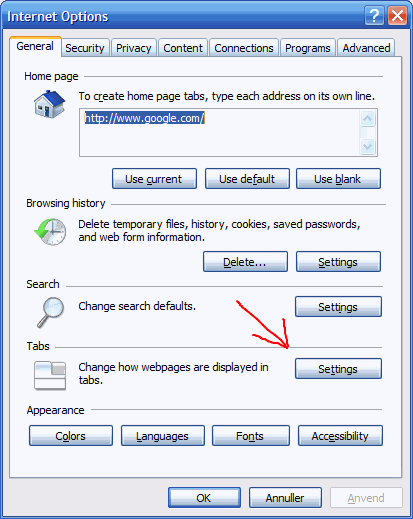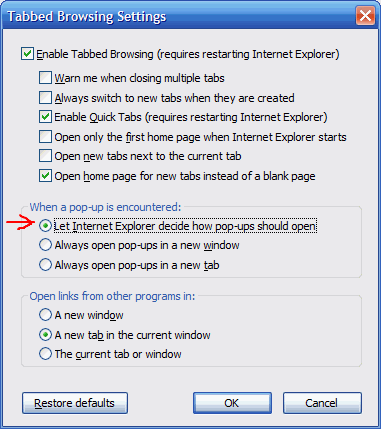Finally Internet Explorer caught up with the rest of the browsers and introduced tabs. For some reason I don’t know, the tabs feature doesn’t work the way you would expect from your experience with Firefox, Opera etc.
All the other browsers with tabs open a new tab when you click a link like this with the target set to _blank:
<a href="example.com" target="_blank">example</a>
This is expected behaviour, but IE7 doesn’t open a new tab, it opens a brand new window just like IE6 instead. This is the default behaviour of IE7 and it might be this way because of backwards compatibility with slow IE6 users. Luckily, there is a way to change the behaviour.
Go to Tools - > Internet Options.

Press the Settings… button in the tab section.

Select the Let Internet Explorer decide how pop-ups should open radio button and click OK.
Some say that screen scraping is a lost art because it is no longer an advanced discipline. That may be right, but there are different ways of doing it. Here are some different ways that all are perfectly acceptable, but can be used for various different purposes.
Old school
It’s old school because this approach has existed since .NET 1.0. It is highly flexible and lets you make the request asynchronously.
public static string ScreenScrape(string url)
{
System.Net.WebRequest request = System.Net.WebRequest.Create(url);
// set properties of the request
using (System.Net.WebResponse response = request.GetResponse())
{
using (System.IO.StreamReader reader = new System.IO.StreamReader(response.GetResponseStream()))
{
return reader.ReadToEnd();
}
}
}
Modern>
In .NET 2.0 we can use the WebClient class, which is a cleaner way of solving the same problem. It is equally as flexible and can also work asynchronous.
public static string ScreenScrape(string url)
{
using (System.Net.WebClient client = new System.Net.WebClient())
{
// set properties of the client
return client.DownloadString(url);
}
}
The one-liner>
This is a short version of the Modern approach, but it deserves to be on the list because it is a one-liner. Tell a nineteen ninetees developer that you can do screen scraping in one line of code and he wont believe you. The approach is not flexible in any way and cannot be used asynchronously.
public static string ScreenScrape(string url)
{
return new System.Net.WebClient().DownloadString(url);
}
That concludes the medley of screen scraping approaches. Pick the one you find best for the given situation.

